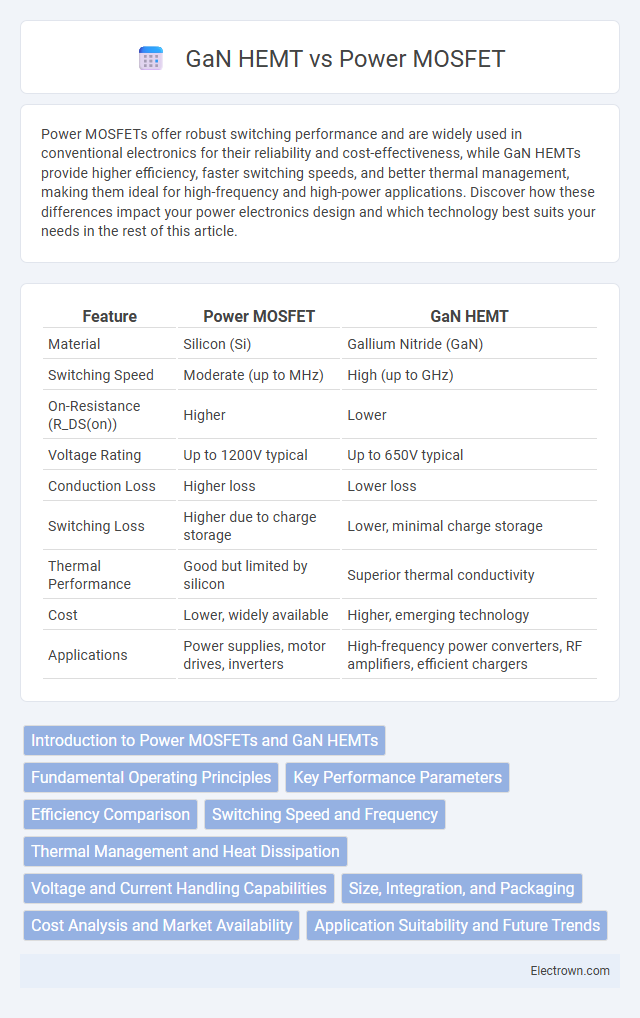Power MOSFETs offer robust switching performance and are widely used in conventional electronics for their reliability and cost-effectiveness, while GaN HEMTs provide higher efficiency, faster switching speeds, and better thermal management, making them ideal for high-frequency and high-power applications. Discover how these differences impact your power electronics design and which technology best suits your needs in the rest of this article.
Table of Comparison
| Feature | Power MOSFET | GaN HEMT |
|---|---|---|
| Material | Silicon (Si) | Gallium Nitride (GaN) |
| Switching Speed | Moderate (up to MHz) | High (up to GHz) |
| On-Resistance (R_DS(on)) | Higher | Lower |
| Voltage Rating | Up to 1200V typical | Up to 650V typical |
| Conduction Loss | Higher loss | Lower loss |
| Switching Loss | Higher due to charge storage | Lower, minimal charge storage |
| Thermal Performance | Good but limited by silicon | Superior thermal conductivity |
| Cost | Lower, widely available | Higher, emerging technology |
| Applications | Power supplies, motor drives, inverters | High-frequency power converters, RF amplifiers, efficient chargers |
Introduction to Power MOSFETs and GaN HEMTs
Power MOSFETs are widely used semiconductor devices known for their efficiency in switching and high voltage handling capabilities, essential in power management applications. GaN HEMTs offer superior electron mobility and higher breakdown voltage, enabling faster switching speeds and greater efficiency in high-frequency and high-power environments. Your choice between Power MOSFETs and GaN HEMTs depends on application requirements such as switching speed, thermal performance, and power density.
Fundamental Operating Principles
Power MOSFETs operate by controlling current flow through a voltage-driven channel formed in a silicon substrate, utilizing an insulated gate to modulate conduction between the source and drain terminals. GaN HEMTs leverage a heterojunction between gallium nitride and aluminum gallium nitride to create a high-electron-mobility two-dimensional electron gas channel, enabling faster switching speeds and higher efficiency. The differing material properties and channel formation mechanisms fundamentally impact their performance in high-frequency and high-power applications.
Key Performance Parameters
Power MOSFETs exhibit higher on-resistance (R_DS(on)) compared to GaN HEMTs, resulting in increased conduction losses under high current conditions. GaN HEMTs provide superior switching speeds and lower gate charge, enabling higher efficiency and reduced switching losses in high-frequency applications. Thermal conductivity and breakdown voltage are also enhanced in GaN devices, making them suitable for compact, high-power density systems where performance and efficiency are critical.
Efficiency Comparison
GaN HEMTs outperform Power MOSFETs in efficiency due to their lower on-resistance and reduced gate charge, leading to significantly lower conduction and switching losses. These characteristics enable GaN devices to achieve higher switching frequencies and improved thermal performance, maximizing power conversion efficiency in applications like power supplies and RF amplifiers. Your choice of GaN HEMTs can result in more compact, energy-efficient systems compared to traditional Power MOSFETs.
Switching Speed and Frequency
GaN HEMTs exhibit significantly higher switching speeds and can operate efficiently at frequencies exceeding 100 MHz, outperforming traditional Power MOSFETs that typically operate below 1 MHz. The superior electron mobility and lower gate charge of GaN devices enable reduced switching losses and faster transitions, making them ideal for high-frequency applications. Power MOSFETs, while reliable for lower-frequency designs, face limitations in efficiency and thermal performance at elevated switching speeds compared to GaN HEMTs.
Thermal Management and Heat Dissipation
Power MOSFETs typically exhibit higher on-resistance, leading to increased power loss and heat generation during operation, which demands robust thermal management solutions such as larger heat sinks or advanced cooling systems. GaN HEMTs offer superior thermal conductivity and lower power dissipation due to their wide bandgap material, enabling more efficient heat dissipation and compact thermal designs. Your choice between Power MOSFET and GaN HEMT significantly impacts cooling requirements, device reliability, and overall system efficiency.
Voltage and Current Handling Capabilities
Power MOSFETs typically handle voltages up to 900V and currents in the range of tens of amperes, making them suitable for medium-power applications. GaN HEMTs surpass these limits by supporting voltages over 600V and currents exceeding 100 amperes, offering superior efficiency and faster switching speeds. Your choice depends on whether you prioritize higher voltage and current capabilities with GaN HEMTs or cost-effective performance in moderate voltage and current ranges with Power MOSFETs.
Size, Integration, and Packaging
GaN HEMTs offer significantly smaller size compared to traditional Power MOSFETs due to their higher electron mobility and efficiency, enabling more compact power conversion systems. Their advanced integration capabilities allow for tighter packaging densities and improved thermal management, reducing overall system footprint. Your choice between the two should consider GaN HEMTs for applications demanding miniaturization and enhanced performance in constrained spaces.
Cost Analysis and Market Availability
Power MOSFETs generally offer lower upfront costs and widespread availability due to established manufacturing processes and mature supply chains. GaN HEMTs, while providing superior efficiency and performance, come at a higher price point and limited market presence, primarily driven by specialized applications and emerging production capabilities. Your choice depends on balancing budget constraints with performance requirements in power electronics designs.
Application Suitability and Future Trends
Power MOSFETs remain a preferred choice for applications requiring moderate switching speeds and cost-effective solutions, such as power supplies and motor controls, due to their mature technology and robustness. GaN HEMTs offer superior performance in high-frequency, high-efficiency applications like RF amplifiers and fast chargers, benefiting from their lower on-resistance and faster switching capabilities. As semiconductor technology advances, GaN HEMTs are increasingly suitable for next-generation power electronics, promising enhanced energy efficiency and power density that could redefine your design possibilities.
Power MOSFET vs GaN HEMT Infographic

 electrown.com
electrown.com